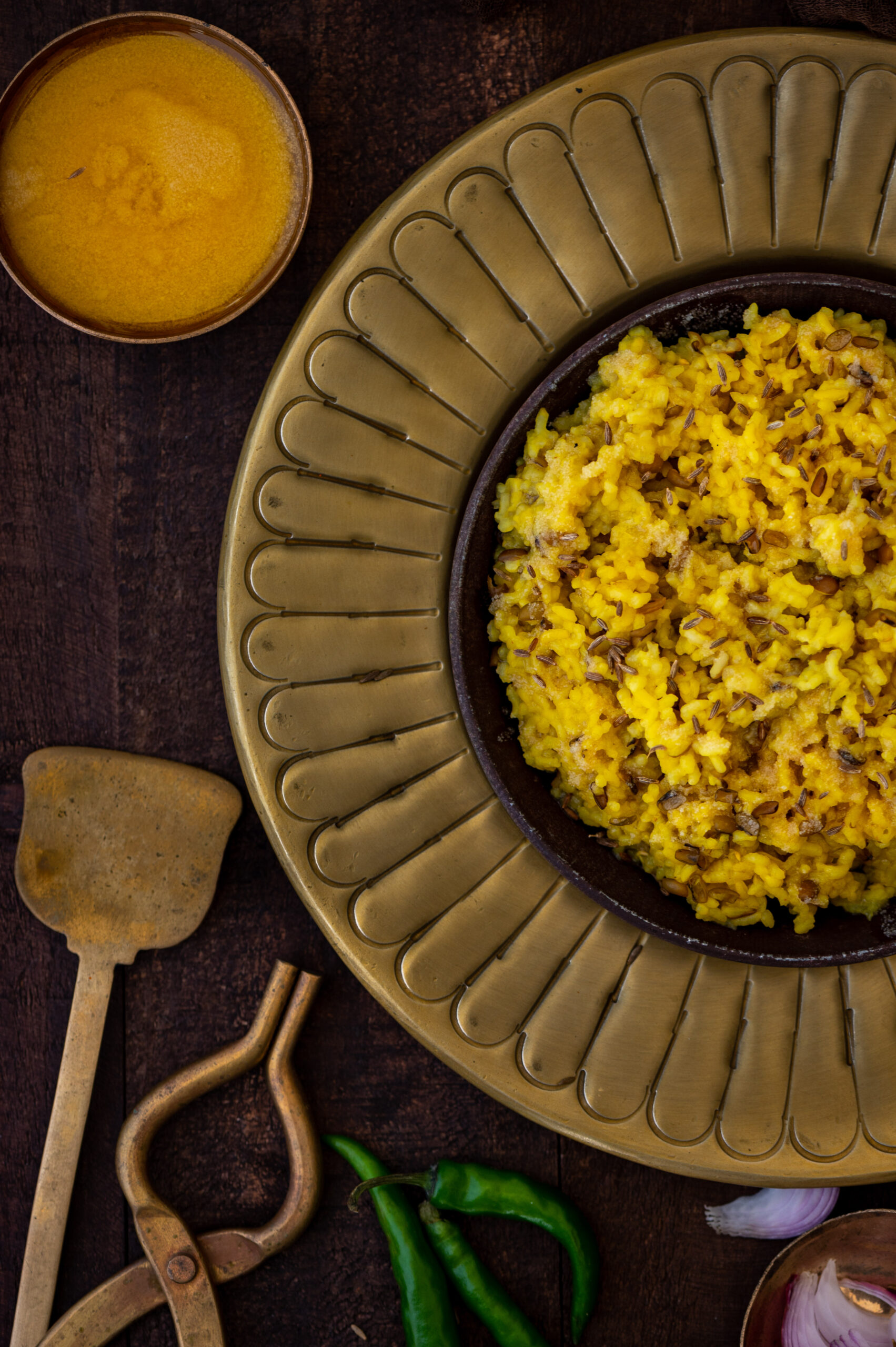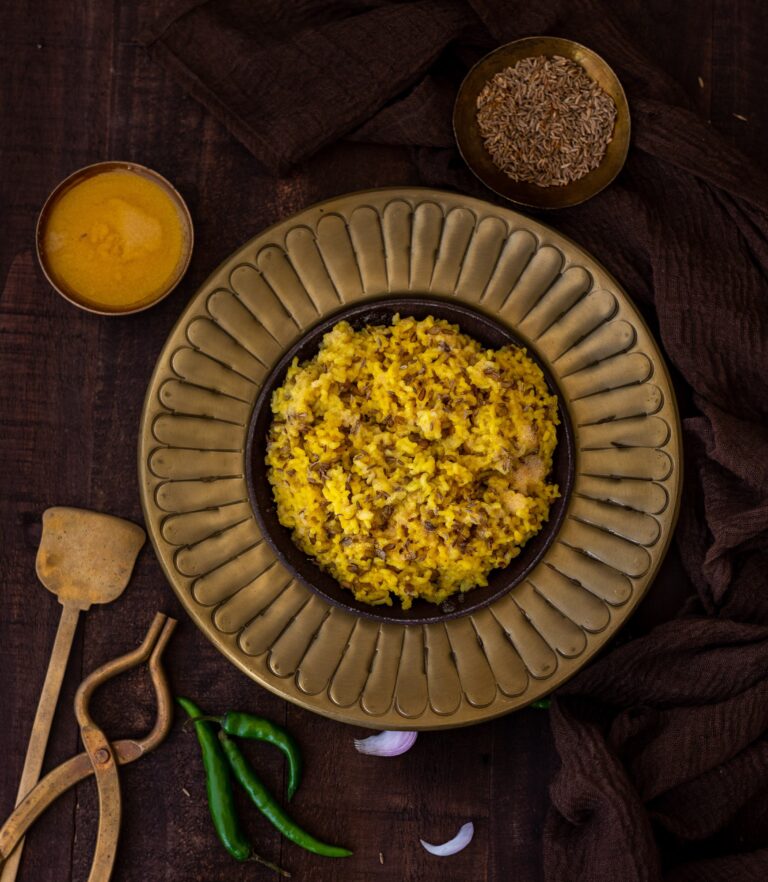Rounding off this series of grain-based, khichdi-like dishes is the simplest, most quotidian version of all: a frequent-use Gujarati-style khichdi. If you’d like to catch up first, we began the series with the work-intensive and tummy-filling seven-grain khichdo and then went on to the versatile breakfast/dinner meal of bajra ghensh). Today, we come to an extremely basic dish, one that is sheer comfort food. What I’ve come to see over the years is that meals that one takes for granted in one’s own home are sometimes novelties in another’s. This is why I often share unassumingly familiar recipes alongside original and unusual ones. This classic khichdi is one among the former category.
Like many staples that are good for our health, khichdi is the kind of dish that kids turn their noses up at. At least, my siblings and I just hated it were growing up. So our mother would negotiate a lot of deals to work around our aversion. In those days, all our food was homemade, so this would take some extra effort on her part. If there was going to be khichdi for dinner, she’d serve something exotic that she learnt at her Continental cuisine or baking classes for lunch. We also cottoned on to the strategy: if there was a special snack in the evening without it being an occasion or a holiday, we knew she was going to put a bowl of khichdi on the table for dinner!
As adults though, it’s a different story. Our palates change and we begin to enjoy food that is good for us, feeling the difference in our bodies when we consume it. In fact, this subcontinental staple (which is eaten in similar forms like pongal in South India) is so relished that it even caught the fancy of the British during the colonial era. They enjoyed a version with fish, a dish they called “kedgeree”, and popularised it in England for a time. It was an import similar to mulligatawny soup, which came from the Tamil dish called molaga-thanni. Some form of khichdi is believed to have been eaten in this part of the world since ancient times, but the recipe reached its pinnacle in the kitchens of the Mughal empire, where its richly spiced and garnished versions are recorded as having been among the favourites dishes of various rulers.
For us at home though, khichdi is neither fancy nor fishy. Every single Gujarati household consumes this khichdi as a comfort food, as well as a frequent meal. During festive seasons or after important occasions like weddings, when the feasting is in full flow, someone or the other will finally say, “Bas (‘enough’), make khichdi today.” That is shorthand for being done with heavy meals, and wanting something that will make the gut smile.
In fact, when I say it is comfort food, I mean that quite literally. It’s the dish that is most commonly made in a home that has just undergone a bereavement, when the family just needs something basic to meet their nutritional needs as they tend to the necessary rituals. Most likely because of its association with grieving, khichdi is never served during celebrations. After them, certainly, as I mentioned above. But never as part of a special event. Neither is it served while entertaining guests. It is very much something that is all about family and simplicity. As we rarely get to encounter another family’s khichdi, I can only guess that the variations between recipes must be innumerable.
So no, khichdi is not special. That’s the best thing about it. It’s a brass tacks dish that gives the body the basics, and uses ingredients that are likely to be in the kitchen at all times. It is comprised mostly of moong dal and rice, with a bit of salt, turmeric and ghee. If it is served with accompaniments, crispy pappads and a bit of kadhi are usually enough. Some potato curry or other vegetable may round out the meal more, if desired. I’ve mentioned kadhi, a type of gravy, a couple of times recently. I’ll be sure to share the recipe for that soon.
Another recipe I will share soon will be for theplas that use leftover khichdi. As I’ve said before: cuisines across all communities in India are innovative when it comes to leftovers. We see poverty everywhere in our country and respect food, acknowledging it as a blessing from God. This in turn becomes a part of our religions too, which discourage food wastage.

Simple Khichdi
(Yield: 2 persons)
75 grams rice
25 grams split mung beans
3 cups water to soak
2 cups water to cook
Salt to taste
¼ teaspoon turmeric
½ teaspoon cumin seeds
2 tablespoons ghee
Wash and soak the rice and dal together for approximately ½ an hour to an hour. I have used split mung beans, but you can try this with other variants including pigeon pea/toor dal. Doing so will change the khichdi somewhat. Toor dal grains will separate like rice does, whereas split mung beans will create a thicker concoction.
Once soaked, discard the soaking water. Place the rice and dal in a pressure cooker along with the cooking water. Use a medium flame. Allow to cook for approximately 20 minutes or 3 whistles, or until the grains are tender and soft to touch.
Allow the pressure to decrease, then open the cooker.
In a small pan, add ghee. Once it is hot, add the cumin seeds. Let them fry until they change colour. Add this cumin-filled ghee to the khichdi. Stir gently and serve hot.
This grain series concludes with this simple and flavoursome recipe. I hope you’ve enjoyed trying out the gamut, from the work-intensive, “holiday special” seven-grain khichdo to the nourishing breakfast that is bajra ghensh, to this basic khichdi that is the ultimate go-to dish. Traditional Gujarati cuisine is something I’ve delved into many times on this blog, and I hope you’ll have a delicious time exploring a wide range of meals, snacks and desserts that I’ve shared here over the years.




